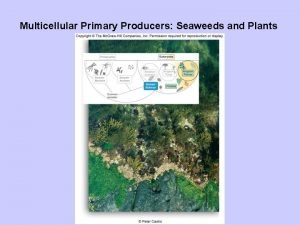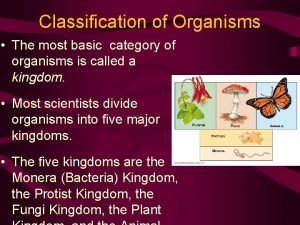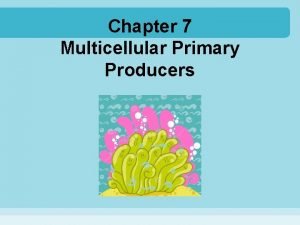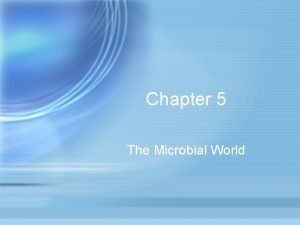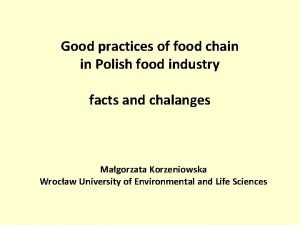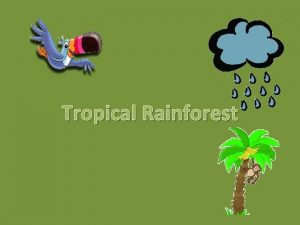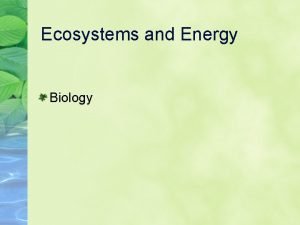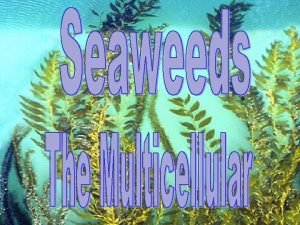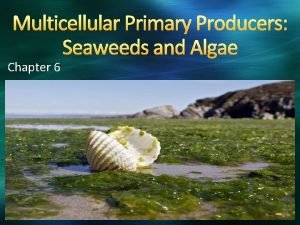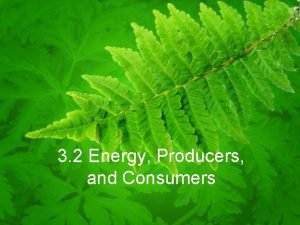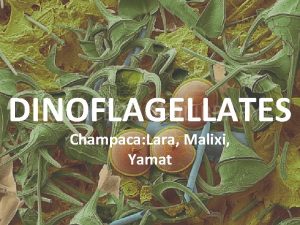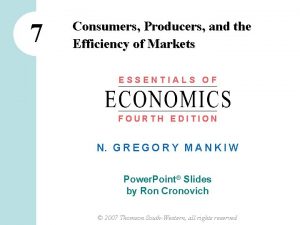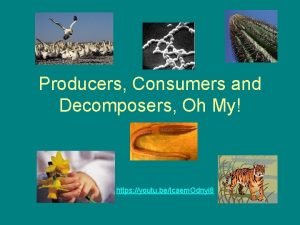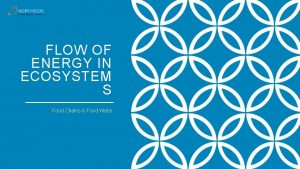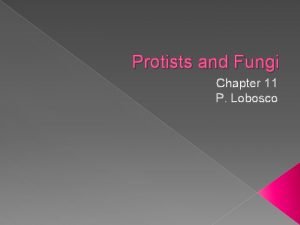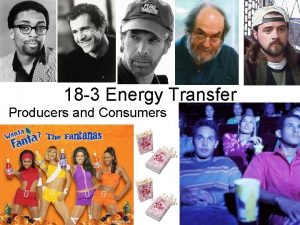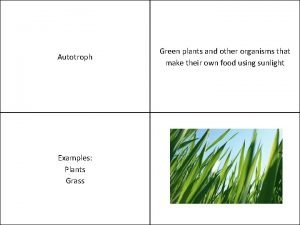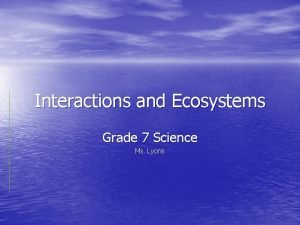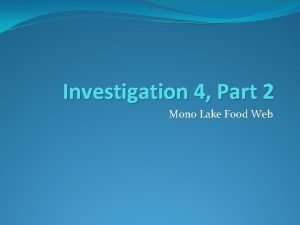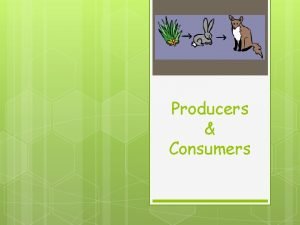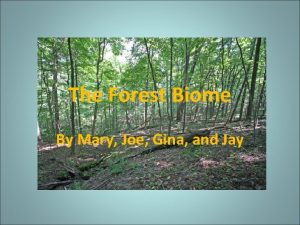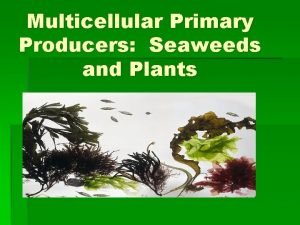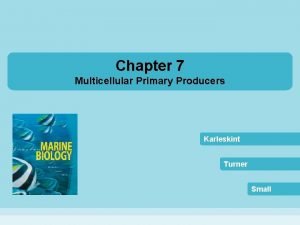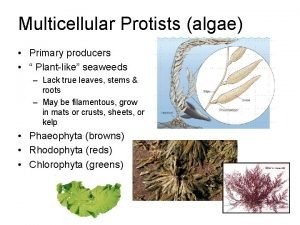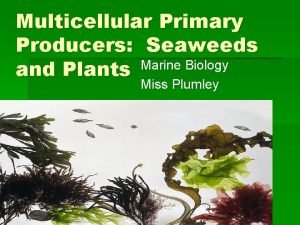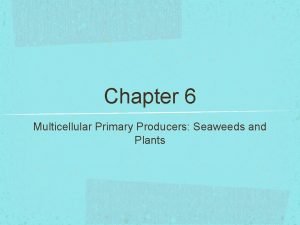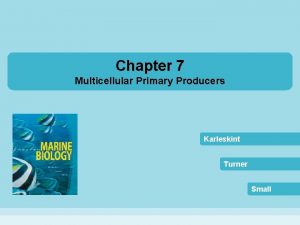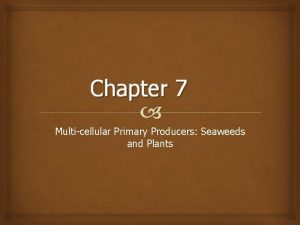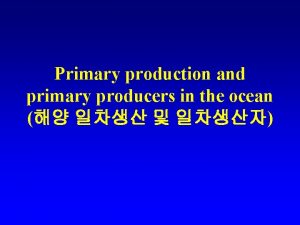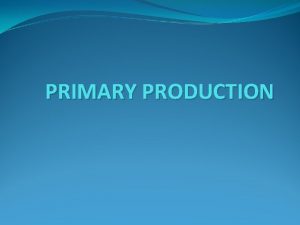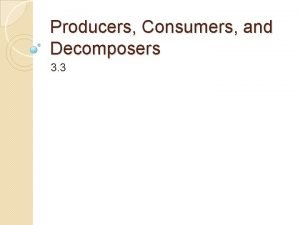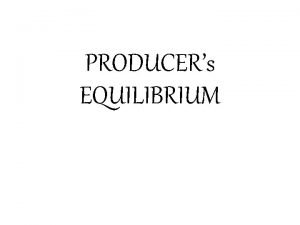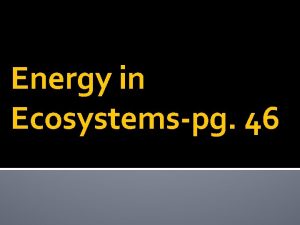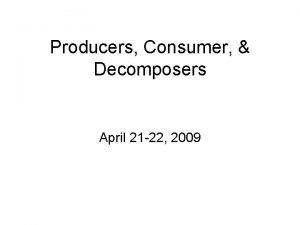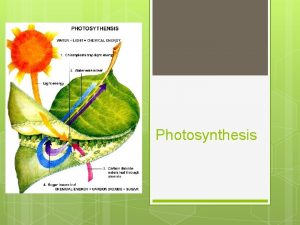Ch 6 Multicellular Primary Producers Ch 6 Multicellular






























- Slides: 30

Ch. 6: Multicellular Primary Producers

Ch. 6: Multicellular Primary Producers: Seaweeds and Plants �When we think of photosynthesizers we think of plants �But in the ocean they are photosynthetic bacteria, unicellular algae (from Ch. 5) and seaweeds! �They are considered plant-like because they are all primary producers �They can photosynthesize

Seaweeds �A type of Algae �Play an important role in coastal environments �Use solar energy to produce organic matter food webs �Organisms live on or in their tissues �Produce oxygen for organisms in the ocean and on land �Can Photosynthesize

6. 1 Multicellular Algae: The Seaweeds �The most familiar types of marine algae are seaweeds �They’re not weeds, so some biologists called them macrophytes or macroalgae �They are multicellular and eukaryotic �More complex structure and reproduction than unicellular algae �less complex than plants �Kingdom Protista

General Structure �Don’t have roots, stems or leaves like plants �The body is known as the thallus �The leaf-like structures �are blades �Large, flat surface for photosynthesis

�Gas-filled bladders called pneumatocysts keep it near the surface to get more sunlight �The stipe is like a stem; it provides support �The holdfast attaches the thallus (body) to the bottom �Cannot anchor in sand, needs a hard bottom �Water and nutrients are absorbed across the surface of the whole alga

B. Types of Seaweeds �Three types: �green, brown & red �Turn paper to the back and make 3 columns labeled green, brown, and red

1. Green Algae – -phylum Chlorophyta � LEAST COMPLEX!!! � Only 10% of 7, 000 species are marine � Found in freshwater, terrestrial, and marine habitats � Simple thallus � Same pigments and food reserves as plants; thought to have evolved into land plants

Green Cont. Common on rocks in shallow water and tide pools � Different sea lettuce (genus Ulva) species are widespread; from polar to tropical waters � � � Halimeda is a calcareous green alga that has deposits of calcium carbonate in its thallus As they die and accumulate they help build coral reefs

Green Seaweed (Algae)

Brown Algae – phylum Heterokontophyta, class Phaeophyta �Color varies from olive green to dark brown � Has more yellowbrown pigments, like fucoxanthin, than chlorophyll � Almost all 1, 500 species are marine �

Brown Algae Cont. � Dominant primary producers on temperate and polar rocky coasts � The largest and most complex seaweeds � Rockweeds (genus Fucus) is found on Atlantic and Pacific coasts of N. America

Brown Algae Cont. � In warm waters (Gulfs of Mexico and California) Sargasso weed (Sargassum) are found Pneumatocysts keep the blades afloat � Some grow on rocks, some float offshore in huge masses � The Sargasso Sea gets name from it �

Brown Cont. � � � The kelps are the largest and most complex of the brown algae Most found below the tide level in temperate and subpolar regions Huge forests grow providing food and shelter for many organisms Laminaria consists of a single large blade up to 10 ft long ¨ Harvested for food in several parts of the world

� � The blade of Alaria can be 80 ft. long Bull kelp, Nereocystis, has a 90 ft. long stipe with a large pneumatocysts and several blades at the top � � � � Macrocystis is the largest of the kelp ¨ Massive holdfast is attached to hard bottoms ¨ Several long stipes and long blades ¨ A pneumatocysts at the base of each blade ¨ Have been found over 300 ft tall! ¨ Can grow 20 inches per day Kelp beds or kelp forests are among

� Kelp beds or kelp forests are among the most productive marine environments � ¨ Found in the colder waters of the � North and South Pacific � ¨ The tops are chopped off to harvest � food and several other natural products

Red Algae – phylum Rhodophyta � Almost all of the 4000 species are marine � More species than all green and brown combined � Have red pigments called phycobilins, which mask the green chlorophyll � Inhabit most shallow-water marine environments � Some are parasites of other seaweeds � Some have no chlorophyll and depend solely on their host


Red Algae Cont. � Can grow as dense clumps in upper tidal areas or long, flat branches in deeper water � Coralline algae deposit calcium carbonate within their cell walls � Encrusting grows on rocks or branched (articulated) like a plant � Their secretions help form coral reefs by cementing it together

STOP WRITING ON CHART!! CONTINUE NOTES Seaweed Life Cycle � Seaweed produces in two ways: � Asexual (vegetative reproduction) is common and more important than sexual reproduction � Thallus fragments of Sargassum can grow into new individuals Spores are resistant cells that can disperse to new locations � Zoospores have flagella for movement � In sexual reproduction gametes from different parents fuse to recombine the genetic information � Each generation shows genetic variation � Cells divide and multiply by mitosis; gametes are � formed by meiosis �

During a seaweed’s life cycle they may exist as one of four different types � One type of thallus is a diploid sporophyte will produce haploid spores � The spores divide and grow into another type of thallus, a haploid gametophyte � The gametophyte produces haploid gametes � The gametes fuse to form a diploid zygote that grows into a sporophyte � This type of life cycle is called alternation of generations � Sometimes the sporophyte looks just like the gametophyte, sometimes the gametophyte is much smaller


Economic Importance � People around the world harvest seaweed for many uses ◦ Mostly as a food source ◦ Also used for fertilizer, animal feed, and wound dressing ◦ Mariculture, the farming of seaweed, is big business in China, Japan & Korea ◦ Seaweeds produce gelatinous phycocolloids used in foods ◦ They produce viscous gels

Algin �– used as a stabilizer and emulsifier in dairy products like ice cream & cheese � ¨ It gives it a smooth texture � ¨ Keeps frosting and pies from becoming dry � ¨ Also found in shampoo, shaving cream, plastics, rubber, paper, paints, cosmetics, and pesticides � ¨ The giant brown kelp, Macrocystis, is a major crop for algin �¨ Harvesting ships off the California coast cut stipes and fronds (blades) to a depth of six feet below the surface

� Carrageenan – used as an emulsifier ◦ ¨ Obtained from red algae ◦ ¨ Gives body to dairy products and pudding � Agar – used for its ability to form jellies ◦ ¨ Obtained from red algae ◦ ¨ Protects ham, fish, and meats during canning ◦ ¨ Used in low-calorie foods, since it is not digestible by humans ◦ ¨ Used as a thickener, in laxatives, and in cosmetics ◦ ¨ Used by biologists to grow bacteria in Petri dishes

6. 2 Flowering Plants � Of the 250, 000 species of plants only a few live in the ocean � They are more evolved than algae, and have true leaves, stems and roots with tissues to transport water and nutrients

Seagrasses � Not really grass, evolved from land plants (the lily family) � About 60 species � Live mostly submerged in shallow waters, such as bays and estuaries

B. Salt-Marsh Plants � Cordgrasses are members of the grass family � Not marine, but can tolerate high salt areas (halophyte) � Salt marshes and coastal mudflats � Salt glands in the leaves excrete excess salt

Mangroves � Adapted to life along tropical and subtropical shores � Land plants that can tolerate salt � Like muddy or sandy shores protected by waves � Include about 80 mostly unrelated species of trees and shrubs

Mangroves Cont. � Have adapted to an environment where salinity is high, water loss from leaves is high, and sediments are soft and poor in oxygen � Thick leaves reduce water loss � Seeds germinate while still attached to the parent � Foot-long seedlings fall and stick into the soft ground like a knife or float in the water to disperse to new locations
 Are algae producers
Are algae producers Members of what kingdom are multicellular producers
Members of what kingdom are multicellular producers Multicellular producers
Multicellular producers Plant and animal cells
Plant and animal cells Massive calcareous mounds formed by cyanobacteria
Massive calcareous mounds formed by cyanobacteria A good food chain
A good food chain Tropical rainforest consumers
Tropical rainforest consumers What are some primary consumers
What are some primary consumers Producers primary consumers secondary consumers
Producers primary consumers secondary consumers Is macroalgae a decomposer
Is macroalgae a decomposer Brown algae
Brown algae What are 3 producers
What are 3 producers Pyrrophyta characteristics
Pyrrophyta characteristics Food chain consumer levels
Food chain consumer levels What do the arrows in the food chain represent
What do the arrows in the food chain represent Yellow magenta and cyan are the ___
Yellow magenta and cyan are the ___ Consumers producers and the efficiency of markets
Consumers producers and the efficiency of markets Producers
Producers Food web energy flow
Food web energy flow Is a horse a producer consumer or decomposer
Is a horse a producer consumer or decomposer How do zooflagellates move
How do zooflagellates move Define producers consumers and decomposers
Define producers consumers and decomposers Marketing channel meaning
Marketing channel meaning Consumers energy
Consumers energy What type of organism is the grass
What type of organism is the grass Types of producers in science
Types of producers in science Fossweb mono lake food web
Fossweb mono lake food web How are written codes used in each of these posters?
How are written codes used in each of these posters? Levels of ecological organization from smallest to largest
Levels of ecological organization from smallest to largest Examples for producers
Examples for producers Joe biome
Joe biome
